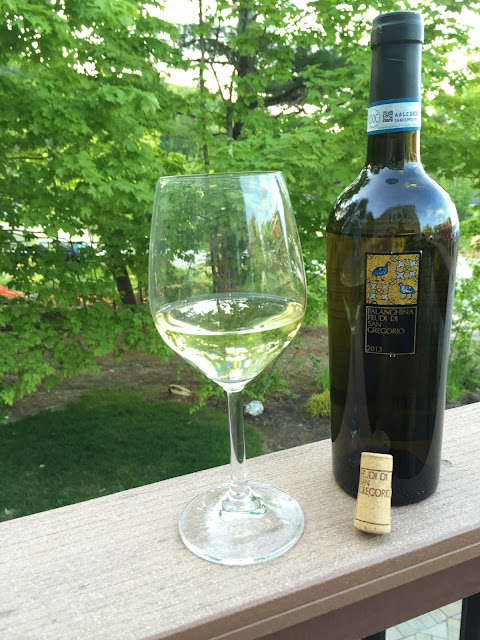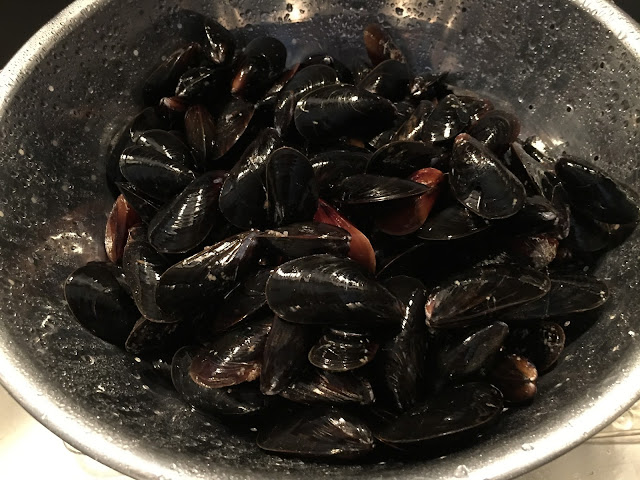Welcome to our 7th month
feature of our Italian Food, Wine & Travel event (#ItalianFWT).
It's been quite fun exploring a different region of Italy every month
with fellow bloggers as we all share our experiences of these
individual regions and what makes them special. This month is
special to me as we feature the region of Campania in southern Italy.
The reason this region is important to me is because my father's
side of the family is from Campania in the province of Avellino and
even further more the town of Candida for those of you from there
that are more familiar with the area. I've been to Campania myself,
but have yet to visit Avellino in particular, but I will get there
some day, especially since Avellino is the largest province for
winemaking in this region.
When I first started this Italian wine
blog it was all about Italian wine, but as I'm having fun with this
it's only normal to pair some of these Italian wines with food. This
is Italy after all and it's all about the Italian food and Italian
wine. I wanted to further seek out some different producers of the
region and some unique grapes, but I'm in the process of closing on a
home and time caught up with me real quick, plus some of the real
unique wines that I'd like to get my hands on aren't that readily
available at local wine shops. I've written an overview of some of
the wines
of the Avellino province previously and today I selected the 2013
Feudi di San Gregorio Falanghina di Avellino. Falanghina is one of
the more popular white indigenous grapes of this region along with
fiano and greco di tufo.
Feudi di San
Gregorio
Feudi di San Gregorio was established
in 1986 via a joint venture of 2 familiar, Capaldo and Ercolino, so
it's a rather young company in comparison to winemaking throughout
the rest of Italy and the world nonetheless. Their winery in Sorbo
Serpico in the Avellino province, Irpinia region, consists of 740
acres (300 hectacres). It's proximity to Mt. Vesuvius and the
volcanic soils there imparts characteristics into the wine that make
wines from this region very special.
The 2013 Feudi di San Gregorio
Falanghina I sampled was medium bodied, aromatic on the nose, with
lots of tropical notes of bananas and pineapples as well as
minerality. This wine is fermented in stainless steel tanks lending
freshness to the wine. (Wine-searcher.com retail average $14.)
Discussion with Antonio Capaldo, Chairman of Feudi di San Gregorio
What makes winemaking in this part of Italy unique?
"Volcanic soils with the unique indigenous varietals and the peculiar climate conditions (over 200 days of rain per year), make Irpinia a wonderful terroir for both white and red wines. Campania is probably one of the most interesting regions for white wines (with Friuli and Alto Adige), but also for red wines."
What qualities does the volcanic soils instill in the wines?
"Minerality is evident in all our wines and greatly supports the body of the wine thus making them quite flexible also for pairing with food. The volcanic soils within Irpinia are not al the same; they go from the volcanis stone in Tufo to the volcanic sand in Aglianico. This way they offer an incredible potential for variety in wines."
What impact has Feudi di San Gregorio had on the history of winemaking in Irpinia?
"Historically Feudi had the merit to bring Campania great history into contemporary society from the style of wine tot he design of the bottles to the communication. After Feudi was successful, over 100 wineries were created in the area."
What is the goal of Feudi di San Gregorio today?
"Today we try to continue accomplishing the mission to lead the system in particular on foreign markets. Together with Mastroberardino in more ancient times, Feudi put Campania on the winemaking map."
Discussion with Antonio Capaldo, Chairman of Feudi di San Gregorio
What makes winemaking in this part of Italy unique?
"Volcanic soils with the unique indigenous varietals and the peculiar climate conditions (over 200 days of rain per year), make Irpinia a wonderful terroir for both white and red wines. Campania is probably one of the most interesting regions for white wines (with Friuli and Alto Adige), but also for red wines."
What qualities does the volcanic soils instill in the wines?
"Minerality is evident in all our wines and greatly supports the body of the wine thus making them quite flexible also for pairing with food. The volcanic soils within Irpinia are not al the same; they go from the volcanis stone in Tufo to the volcanic sand in Aglianico. This way they offer an incredible potential for variety in wines."
What impact has Feudi di San Gregorio had on the history of winemaking in Irpinia?
"Historically Feudi had the merit to bring Campania great history into contemporary society from the style of wine tot he design of the bottles to the communication. After Feudi was successful, over 100 wineries were created in the area."
What is the goal of Feudi di San Gregorio today?
"Today we try to continue accomplishing the mission to lead the system in particular on foreign markets. Together with Mastroberardino in more ancient times, Feudi put Campania on the winemaking map."
Cuisine of Campania
Some of the cuisine of Campania
includes shellfish and seafood based on its close proximity along the
Adriatic Sea so I chose to pair the Feudi di San Gregorio Falanghina
with mussels from my mothers recipe that I love. I actually was
always afraid growing up to try mussels and this recipe made it easy
to love. Nothing better than learning directly from my mother whom
was taught by her Italian grandmother. No ones cooking is like my
mothers and I guarantee this recipe is sure to please.
Mussels
Ingredients
3-4 tablespoon of olive oil
2-3 cloves of garlic
1 cup of white wine
2 bay leaves
2 bay leaves
1 tablespoon of sea salt
14 oz can of chopped tomatoes
½ onion (optional)
1/4-1/2 teaspoon of red pepper flakes
(optional)
Clean the mussels prior to cooking.
Put them into whatever size pot or dish that makes it easy to run
water over them washing them off. Sprinkle flour over them and toss
them in the bowl. Some folks also use cornmeal instead of the flour.
Those mussels that are open make sure to discard them.
Once the mussels are cleaned, put aside
and add oil to a pot and heat oil prior to adding ingredients. Add
onions and saute the onion for about 3-4 minutes. In the last couple
minutes add garlic. Add the red pepper flakes along with a can of
chopped tomatoes and bay leaves. Simmer for about 10 minutes. Combine mussels with
the white wine within the pot. Bring to a boil and cover until
mussels open.
We enjoyed these mussels as an appetizer, but you can combine them
with pasta. Either way you'll get a taste of Campania with this
pairing that will make you wanting more.
What's your favorite Campanian wine or food?
Foodwineclick -- Neopolitan Pork Chops and Autochthnous Grapes of Campania
Rockin Red Blog -- Exploring Campania with #ItalianFWT
Cooking Chat -- Grilled Swordfish with Pasta Margherita
ENOFYLZ Wine Blog -- A Taste of Campania with #ItalianFWT
Curious Appetite -- Strange Foods and Fringe Wines of Campania
Christys Palate - Flying Squid Pasta with Beneventano Falanghina
We'd love to have you join our Twitter Chat Saturday, June 6, at 11 a.m Eastern time/ 5 p.m. Italian time. Some of our bloggers had last minute computer troubles so we may be a bit quieter than usual! Blogs that were posted as of Saturday 6/6, 7 a.m. ET have live links to their posts in the list above; check back as the others will be sharing their posts soon! Next month we will be featuring Lazio!
I find this wine map very useful to understand not only Campania, but all the wine regions of Italy.




No comments:
Post a Comment